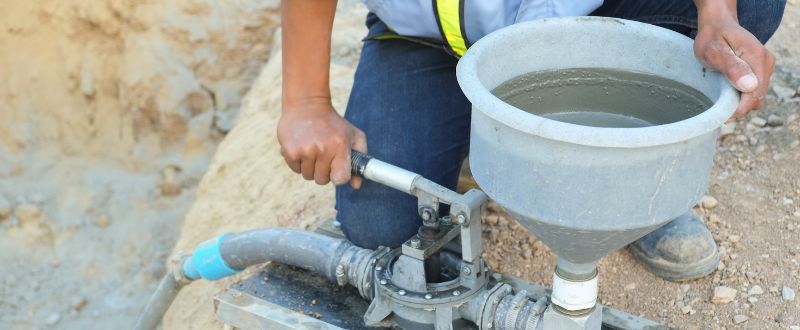Concrete lifting is essential for ensuring safety, maintaining visual appeal, preventing water-related problems, and preserving the longevity of structures. When concrete sinks, it can create uneven surfaces that increase the risk of accidents and injuries.
The most significant potential problem of sinking concrete is how it affects the structural integrity of buildings and infrastructure, potentially resulting in cracks, shifts, and other damage. Learn about the different concrete lifting methods for various surfaces to understand your repair options.
Mudjacking
Mudjacking is a technique where a specialized mud mixture is pumped beneath the concrete to lift it. This method is commonly used for garage floors, sidewalks, driveways, and patio slabs. One of the primary advantages of mudjacking is its affordability; it can cost less than half the price of replacing the concrete.
However, since mudjacking uses a water-based mixture, it requires several hours to dry or cure. The water in the mixture can also react to changes in the weather and cause the mixture to decay. Over time, this could lead to additional settling and the need for further lifting or repairs.
Polyurethane Foam Injection
Polyurethane foam injection is a more innovative concrete lifting method than mudjacking and pressure grouting. Polyurethane foam injection is suitable for lifting concrete slabs such as driveways or the interior areas of foundations.
A technician injects polyurethane foam under the concrete slab through small holes, each about the size of a penny. The foam expands rapidly, lifting the concrete and filling voids underneath the slab.
Polyurethane foam is much more lightweight than the slurries used in mudjacking and slabjacking. Heavier materials add weight to the top of the soil and may increase its instability, making the concrete susceptible to sinking again. Additionally, the foam cures quickly and provides a water-resistant solution, which makes it an exceptional method for concrete lifting in Houston.
Concrete Piling
Lastly, concrete piling is a method that can support and lift a wide range of structures, including homes and light commercial buildings. This technique involves driving concrete pilings, or columns, into the ground beneath the structure until they reach a stable soil layer.
This method transfers the load from unstable soil to the pilings. Concrete piling offers long-lasting and extremely stable support, but it can be more invasive and time-consuming compared to the other methods. Because of its precision, this method is effective for lifting concrete foundation perimeters and corners.
Understanding the different concrete lifting methods for various surfaces will help you choose a more effective and long-lasting solution for your structure. Speak to an experienced professional to ensure safety, efficiency, and quality results.

